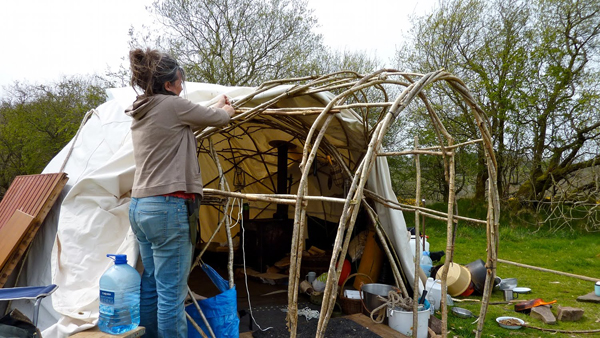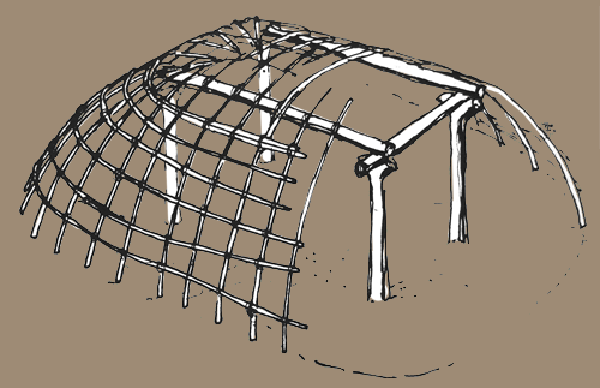
“A wigwam or wickiup is a domed room dwelling used by many different Native American cultures. The curved surfaces make it an ideal shelter for all kinds of conditions. These structures are formed with a frame of arched poles, most often wooden, which are covered with some sort of roofing material. Details of construction vary with the culture and local availability of materials. Some of the roofing materials used include grass, brush, bark, rushes, mats, reeds, hides or cloth.”
“A bender tent is a simple shelter. A bender is made using flexible branches or withies, such as those of hazel or willow. These are lodged in the ground, then bent and woven together to form a strong dome-shape. The dome is then covered using any tarpaulin available. These tents can be heated during the winter using a woodburning stove, and they are easily capable of withstanding very strong winds so long as the covers are well weighed down.”

These shelters are made with minimal resources gathered from the site (mostly flexible branches or saplings) and are easy to dismantle and take with you. Many shapes are possible – tunnels (vaults), domes, lean-to, free form or combination of shapes. Adding a protective flap or overhang over the entrance helps block snow and rain, and creates space for a small fire. A plastic or canvas tarp blocks wind and rain, and traps warm air inside. An optional space blanket will reflect heat into the shelter. In cold climates the roof could be covered with multiple materials for improved performance: space blanket on inner layer, insulating material such as blankets, bundled grass, pine boughs or mounded leaves, and waterproof tarp for outer covering. Raise the floor if necessary in wet or cold climates. For instance, a raised floor with insulation underneath will provide a cold air sink. These improved versions are sometimes called super shelters. Add a closed cell foam sleeping pad, good sleeping bag and firepit and you could comfortably survive in most any climate. A larger, sturdy, well made wigwam or bender with adequate living space could provide decent shelter for years at negligible cost.
Source: Wiki
Source: Wiki
Image source: Heart and Soil
Image source: Rustic Buildings
Related:
Camp Bling Shelter Construction (good advice based on actual experience)
Mungo Says Bah (good advice about raising the floor to create a sink for cold air and leaves for insulation)

I do living history camps as Woodland Native Americans. I would like to be able to sorce the wood to make the Wiki hut or wigwam frame.
nice idea! oh, may as well delete the “camp bling” link. it’s dead.
I want one !
It’s easy to improve a basic shelter if you want. For example, see the 2nd image: A steep roof could be added to improve drainage.